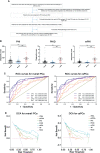Modified Prostate Health Index Density Significantly Improves Clinically Significant Prostate Cancer (csPCa) Detection
- PMID: 35463344
- PMCID: PMC9021722
- DOI: 10.3389/fonc.2022.864111
Modified Prostate Health Index Density Significantly Improves Clinically Significant Prostate Cancer (csPCa) Detection
Abstract
Background: Early screening of clinically significant prostate cancer (csPCa) may offer opportunities in revolutionizing the survival benefits of this lethal disease. We sought to introduce a modified prostate health index density (mPHI) model using imaging indicators and to compare its diagnostic performance for early detection of occult onset csPCa within the prostate-specific antigen (PSA) gray zone with that of PHI and PHID.
Methods and participation: Between August 2020 and January 2022, a training cohort of 278 patients (total PSA 4.0-10.0 ng/ml) who were scheduled for a prostate biopsy were prospectively recruited. PHI and PHID were compared with mPHI for the diagnosis performance in identifying csPCa. Pathology outcomes from systematic prostate biopsies were considered the gold standard.
Results: This model was tested in a training cohort consisting of 73 csPCa, 14 non-clinically significant prostate cancer(non-csPCa), and 191 benign prostatic hyperplasia (BPH) samples. In the univariate analysis for the PSA gray zone cohort, for overall PCa, the AUC of mPHI (0.856) was higher than PHI (0.774) and PHID (0.835). For csPCa, the AUC of mPHI (0.859) also surpassed PHI (0.787) and PHID (0.825). For detection of csPCa, compared with lower specificities from PHI and PHID, mPHI performed the highest specificity (76.5%), by sparing 60.0% of unnecessary biopsies at the cost of missing 11 cases of csPCa. The mPHI outperformed PHI and PHID for overall PCa detection. In terms of csPCa, mPHI exceeds diagnostic performance with a better net benefit in decision curve analysis (DCA) compared with PHI or PHID.
Conclusions: We have developed a modified PHI density (mPHI) model that can sensitively distinguish early-stage csPCa patients within the PSA gray zone.
Clinical trial registration: ClinicalTrials.gov, NCT04251546.
Keywords: PSA; clinically significant prostate cancer; gray zone; mPHI; prostate health index density.
Copyright © 2022 Chen, Qian, Wu, Shi, Zhou, Qu, Gu, Ding and Yu.
Conflict of interest statement
The authors declare that the research was conducted in the absence of any commercial or financial relationships that could be construed as a potential conflict of interest.
Figures

References
Associated data
LinkOut - more resources
Full Text Sources
Medical
Research Materials
Miscellaneous

